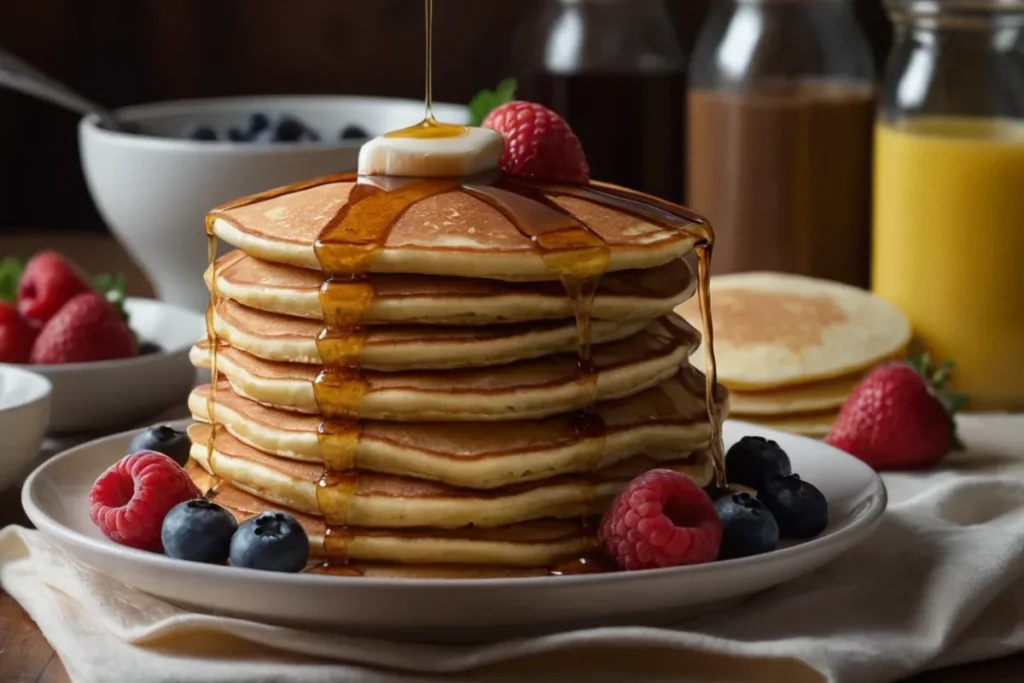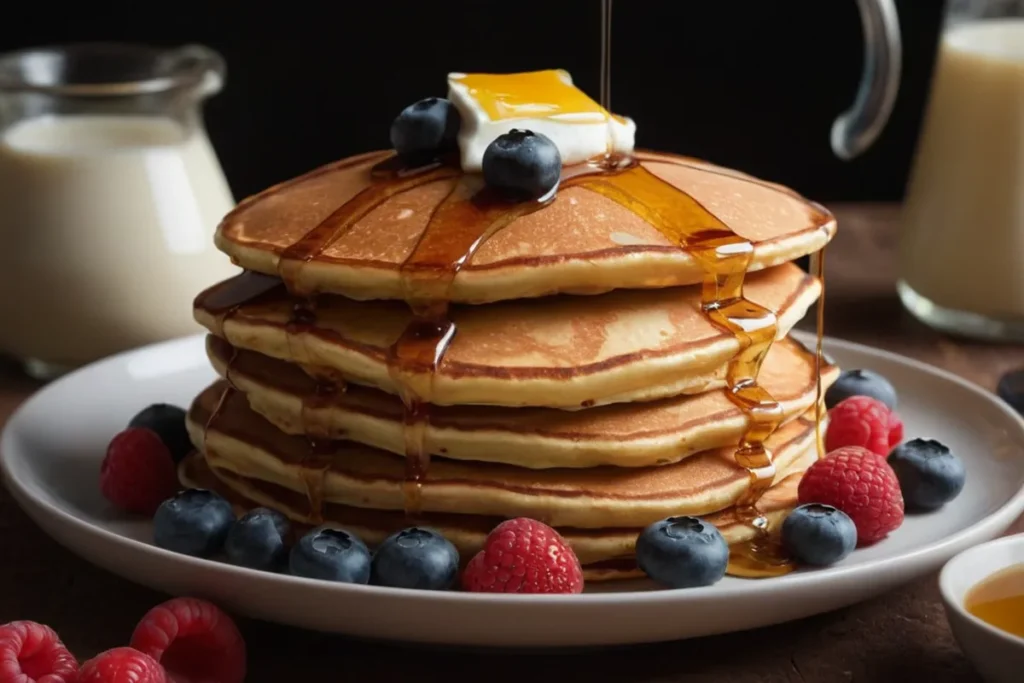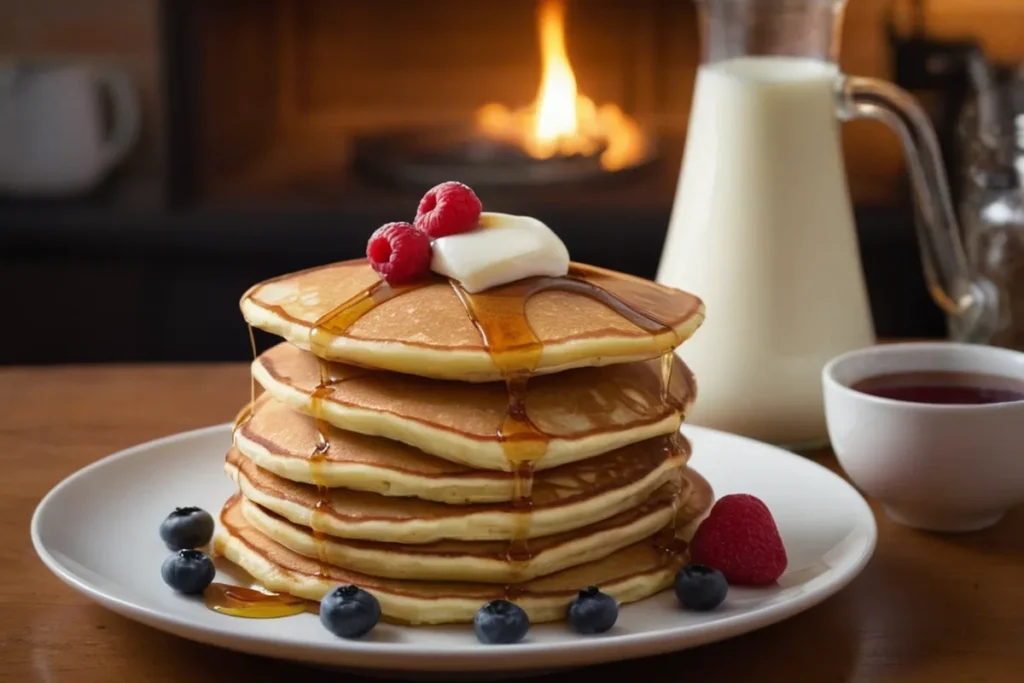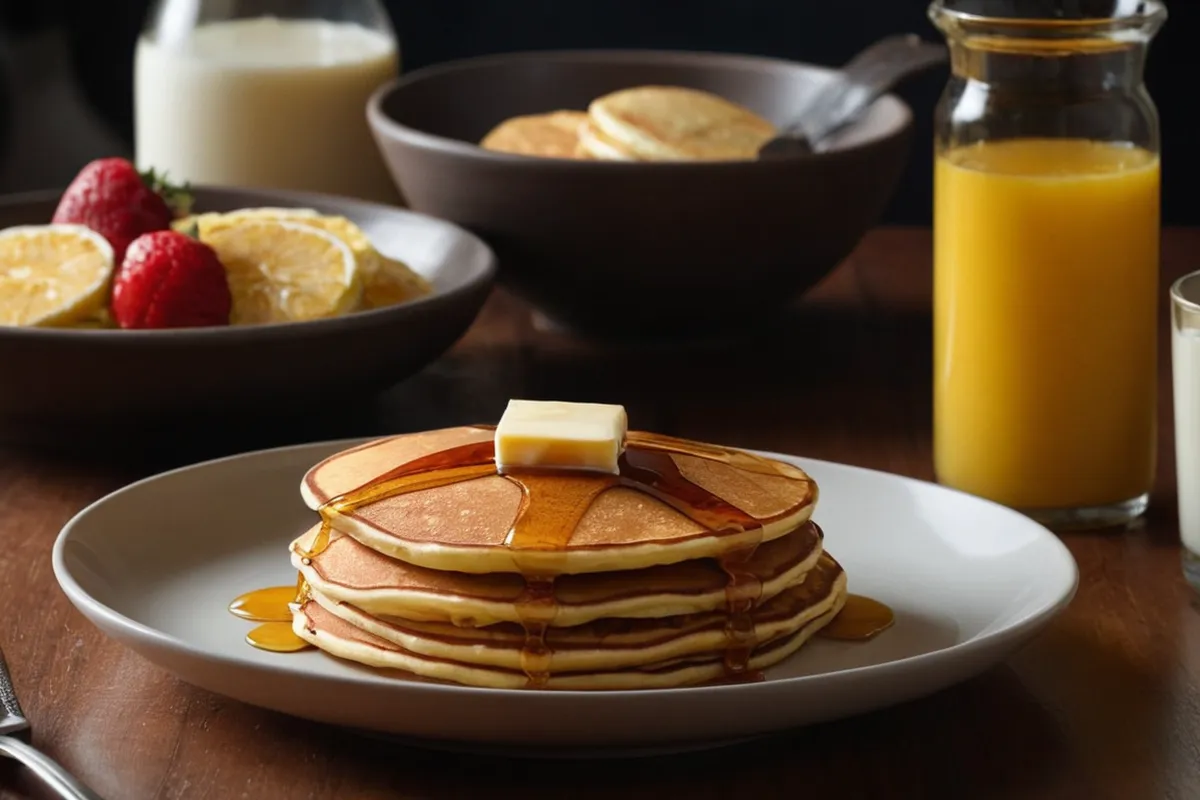Pancakes are a breakfast classic, loved for their simplicity and versatility. But if you’ve ever asked yourself, what are the ingredients for pancakes, you’re not alone. The magic behind a perfect stack lies in a few essential ingredients that work together to create those light, fluffy pancakes we all crave. Whether you’re a beginner or a seasoned cook, understanding what are the ingredients for pancakes is key to mastering this beloved dish. In this comprehensive guide, we’ll explore each ingredient in detail, ensuring you have all the knowledge needed to whip up the perfect pancakes every time.
The Essential Ingredients for Pancakes
When diving into the question of what are the ingredients for pancakes, it’s important to start with the basics. These foundational ingredients are what give pancakes their structure, flavor, and texture, making them the breakfast staple they are today.
All-Purpose Flour: The Foundation of Pancake Batter
The first and most crucial answer to what are the ingredients for pancakes is all-purpose flour. Flour is the backbone of your pancake batter, providing the structure that holds everything together. It’s no surprise that all-purpose flour is the most common type used in pancakes due to its perfect balance of protein and starch, essential for creating pancakes that are both fluffy and tender.
Alternative Flour Options
- Whole Wheat Flour: Adds a nuttier flavor and increases the fiber content, making pancakes heartier.
- Almond Flour: A great gluten-free alternative that gives pancakes a slightly sweet, nutty taste.
- Coconut Flour: Low in carbs and rich in fiber, but it requires more liquid due to its high absorbency.
Each type of flour brings something unique to the table, allowing you to customize your pancakes based on dietary needs or flavor preferences.
Baking Powder: The Key to Fluffiness

Another essential component when considering what are the ingredients for pancakes is baking powder. This leavening agent is responsible for the pancakes’ rise, making them light and fluffy. Baking powder works by releasing carbon dioxide gas into the batter when it reacts with liquid and heat, causing the batter to expand and puff up during cooking.
Substitutes for Baking Powder
- Baking Soda and Vinegar: A combination that can substitute for baking powder in a pinch, with ¼ teaspoon of baking soda and ½ teaspoon of vinegar replacing 1 teaspoon of baking powder.
- Self-Rising Flour: Contains baking powder, so you can skip adding additional leavening agents.
Sugar: Sweetening and Caramelizing
If you’re asking what are the ingredients for pancakes that contribute to their flavor and appearance, sugar is a key player. Sugar not only sweetens the pancakes but also helps them brown beautifully as they cook. The amount of sugar can be adjusted depending on how sweet you like your pancakes.
Different Types of Sugar to Use
- Granulated Sugar: The standard sugar used in most pancake recipes, providing a straightforward sweetness.
- Brown Sugar: Adds a hint of molasses flavor and extra moisture, resulting in richer pancakes.
- Honey or Maple Syrup: Natural sweeteners that can replace sugar, though you may need to reduce the liquid in the batter slightly to maintain the right consistency.
Salt: Enhancing and Balancing Flavors
When pondering what are the ingredients for pancakes, salt might seem minor, but it plays a crucial role in enhancing the other flavors. A small pinch of salt helps to balance the sweetness and brings out the nuances of the other ingredients.
How Much Salt to Add
- A typical pancake recipe calls for about ¼ teaspoon of salt. Adjust according to your taste and whether you’re using salted butter.
Liquid Ingredients in Pancake Batter
Liquid ingredients are essential when determining what are the ingredients for pancakes. They combine the dry ingredients and create a smooth batter that’s easy to work with.
Milk: The Primary Liquid Base
Milk is usually the main liquid in pancake batter. It hydrates the flour, dissolves the sugar and salt, and helps create a smooth, pourable consistency. When considering what are the ingredients for pancakes that contribute to texture and flavor, milk is indispensable.
Dairy-Free Alternatives
- Almond Milk: A non-dairy option that adds a subtle nutty flavor.
- Soy Milk: Similar in consistency to cow’s milk, with a richer taste.
- Oat Milk: Thicker than other milk alternatives, it adds creaminess and can make pancakes even fluffier.
These alternatives are perfect for those with dietary restrictions or preferences, ensuring everyone can enjoy delicious pancakes.
Eggs: Binding and Enriching the Batter
Eggs play a vital role in binding the ingredients together and enriching the batter. When asking what are the ingredients for pancakes, eggs are a common answer because they contribute to the texture and structure, helping to create light, fluffy pancakes.
Egg Substitutes for Vegans
- Flaxseed Meal and Water: Mix 1 tablespoon of flaxseed meal with 3 tablespoons of water to replace one egg, adding fiber and a slight nuttiness.
- Applesauce: Use ¼ cup of unsweetened applesauce as an egg substitute, which also adds moisture and a touch of sweetness.
- Mashed Banana: Replacing eggs with mashed banana adds moisture and a mild banana flavor, perfect for a unique twist on traditional pancakes.
These substitutes are ideal for those following a vegan diet or who need to avoid eggs due to allergies.
Butter or Oil: Adding Richness and Moisture

Fat is a crucial ingredient when considering what are the ingredients for pancakes. It adds moisture, flavor, and helps achieve that perfect golden-brown color on the outside. Both butter and oil are commonly used, each offering different benefits.
Differences Between Butter and Oil
- Butter: Provides a rich flavor and tender texture. Use melted butter for easy incorporation into the batter.
- Oil: Results in a lighter texture and is a better option for those avoiding dairy.
Healthier Alternatives to Butter
- Coconut Oil: Adds a slight coconut flavor and is a healthier fat option, rich in medium-chain triglycerides (MCTs).
- Olive Oil: Offers a savory note and is packed with healthy fats, though it may slightly alter the flavor of the pancakes.
Enhancing Flavor with Optional Ingredients
Once you’ve mastered the basics of what are the ingredients for pancakes, you can begin experimenting with optional ingredients that enhance flavor and make your pancakes unique.
Vanilla Extract: A Simple Flavor Boost
Vanilla extract is a common addition that adds a subtle yet profound depth of flavor to pancakes. When thinking about what are the ingredients for pancakes that can elevate the dish without overwhelming it, vanilla is an excellent choice.
Spices: Adding Warmth and Complexity
Spices like cinnamon, nutmeg, or ginger can transform your pancakes into a cozy, warming breakfast treat. These are especially popular in recipes meant for colder months, where a bit of spice adds a comforting touch.
Add-ins: Customizing Your Pancakes
Add-ins such as chocolate chips, fruits, or nuts are excellent for personalizing your pancakes. When considering what are the ingredients for pancakes that make them stand out, these extras can take your breakfast to the next level.
Popular Add-ins for Pancakes
- Blueberries: Add a juicy burst of flavor and antioxidants.
- Chocolate Chips: For those with a sweet tooth, chocolate chips provide a rich, melty center.
- Bananas and Nuts: Combine these for a heartier, more filling pancake.
Understanding Ingredient Ratios and Measurements
When exploring what are the ingredients for pancakes, it’s essential to understand the importance of ratios and measurements. The right balance of ingredients is crucial to achieving the desired texture and flavor.
Adjusting Ingredients for Desired Texture
If you prefer thicker, fluffier pancakes, you may need to increase the flour slightly or reduce the liquid. For thinner pancakes, like crepes, increase the liquid or use less flour. The key to mastering what are the ingredients for pancakes is knowing how to tweak these ratios based on your preferences.
Scaling the Recipe for Larger Batches
- To make a larger batch of pancakes, double or triple the ingredients accordingly. Just be sure to mix the batter thoroughly to ensure even distribution of all components.
Substituting Ingredients for Dietary Needs
When contemplating what are the ingredients for pancakes, you may need to make substitutions based on dietary restrictions or personal preferences.
Gluten-Free Pancake Ingredients
For gluten-free pancakes, substitute all-purpose flour with a gluten-free flour blend. Some recipes also recommend adding a small amount of xanthan gum to improve the texture, which helps mimic the elasticity of gluten.
Vegan Pancake Ingredients
As discussed earlier, you can replace eggs with flaxseed meal, applesauce, or bananas, and use a non-dairy milk like almond or soy. These substitutions answer what are the ingredients for pancakes that cater to a vegan diet while still producing delicious results.
Low-Calorie Pancake Ingredients
To create a lower-calorie pancake, consider using whole wheat flour instead of all-purpose flour, replacing sugar with a zero-calorie sweetener like Stevia, and opting for non-fat milk or almond milk.
The Role of Each Ingredient in Pancake Batter
Understanding what are the ingredients for pancakes is more than just knowing the components; it’s about understanding how each ingredient works in the recipe.
Flour: Providing Structure
Flour forms the backbone of your pancake batter, giving it the structure it needs to hold together while cooking. The gluten in the flour traps air bubbles created by the baking powder, leading to a light and airy texture. Without flour, pancakes would lack the necessary framework to rise and maintain their shape.
Baking Powder: Creating Lift and Fluffiness
Baking powder is the key to fluffy pancakes. It reacts with the liquids in the batter to release carbon dioxide gas, which gets trapped in the gluten structure created by the flour. This process causes the pancakes to rise, making them light and airy. If you omit or skimp on the baking powder, you’ll end up with dense, flat pancakes.
Eggs: Binding Ingredients and Adding Richness
Eggs serve multiple roles in pancake batter. They bind the ingredients together, provide moisture, and add richness. The proteins in the eggs help set the structure as the pancakes cook, while the fats add tenderness and flavor. If you omit eggs, the pancakes may be crumbly and less cohesive, which is why it’s important to use effective substitutes if you’re making vegan pancakes.
Milk: Adding Moisture and Tenderness
Milk is another essential ingredient that contributes to the moisture and tenderness of pancakes. It hydrates the flour and helps to create a smooth batter. The fat content in the milk also adds richness and helps produce a tender crumb. Using dairy or non-dairy alternatives can affect the flavor and texture, but with the right adjustments, you can still achieve a delicious result.
Sugar: Sweetening and Caramelizing
Sugar not only sweetens the pancakes but also aids in browning them as they cook. The sugar caramelizes on the surface of the pancakes, giving them a beautiful golden-brown color. Without sugar, the pancakes may lack the desired sweetness and won’t brown as well, resulting in a paler appearance.
Butter or Oil: Adding Fat and Flavor
Butter or oil is crucial for adding fat to the pancake batter, which contributes to a moist and flavorful pancake. The fat also helps create a crispy, golden-brown exterior. If you’re looking for a healthier alternative, coconut oil or olive oil can be used, but keep in mind they may alter the flavor profile slightly.
Tips for Mixing Pancake Batter
Now that you know what are the ingredients for pancakes and their roles, it’s time to focus on how to mix them properly. The way you combine the ingredients can significantly impact the texture of your pancakes.
Avoid Over-Mixing
One of the most common mistakes when making pancake batter is over-mixing. Over-mixing activates the gluten in the flour too much, leading to tough, dense pancakes instead of light and fluffy ones. To avoid this, mix the batter just until the dry ingredients are incorporated. A few lumps are okay and will smooth out during cooking.
Achieving the Right Batter Consistency
The consistency of your pancake batter is key to the final texture of your pancakes. When thinking about what are the ingredients for pancakes, consider the ratio of wet to dry ingredients. A thicker batter will result in thicker, fluffier pancakes, while a thinner batter will yield thinner, more delicate pancakes. If your batter is too thick, add a little more milk to thin it out. If it’s too thin, sprinkle in a bit more flour.
Using the Resting Time to Enhance Fluffiness
Allowing the pancake batter to rest for about 10-15 minutes before cooking can make a significant difference. Resting gives the flour time to fully hydrate, reducing lumps and allowing the baking powder to activate fully. This step is often overlooked but is crucial for achieving the fluffiest pancakes possible.
Cooking the Perfect Pancakes

With your batter ready, it’s time to cook the pancakes. Proper cooking technique is essential to make the most of the ingredients and ensure your pancakes turn out perfectly every time.
Choosing the Right Cooking Surface
The cooking surface you choose can greatly impact how your pancakes turn out. A non-stick griddle or frying pan is ideal because it ensures even cooking and makes flipping pancakes easier. Cast iron skillets are also a great choice as they retain heat well, leading to evenly cooked pancakes with a beautiful golden-brown crust.
Ideal Cooking Temperature
Cook your pancakes over medium heat. If the heat is too high, the pancakes will brown too quickly on the outside while remaining raw in the center. If the heat is too low, the pancakes will take longer to cook and may not develop that desirable golden color. To test if your griddle is at the right temperature, sprinkle a few drops of water on the surface—if they sizzle and evaporate quickly, you’re good to go.
Tips for Flipping Pancakes Perfectly
- Wait for Bubbles: The best time to flip your pancakes is when bubbles form on the surface and the edges start to look set. This usually takes about 2-3 minutes.
- Use a Wide Spatula: A wide, flat spatula is ideal for flipping pancakes without breaking them.
- Flip with Confidence: Slide the spatula under the pancake and flip it with a quick, confident motion. Cook for another 1-2 minutes on the other side until golden brown.
Troubleshooting Common Pancake Problems
Even with the best ingredients and techniques, sometimes pancakes don’t turn out as expected. Here are some common issues and how to fix them.
Why Are My Pancakes Flat?
If your pancakes are turning out flat, it could be due to old baking powder that has lost its potency. Always check the expiration date on your baking powder and test it by adding a teaspoon to hot water—if it bubbles, it’s still good. Over-mixing the batter can also cause flat pancakes, as it deflates the air bubbles needed for fluffiness.
Why Is My Pancake Batter Lumpy?
A few lumps in the batter are normal and can actually result in fluffier pancakes. However, if your batter is excessively lumpy, it might be due to not mixing the ingredients thoroughly enough. To avoid this, sift the dry ingredients before adding them to the wet ingredients, and mix gently until just combined.
Why Are My Pancakes Too Dense?
Dense pancakes can result from too much flour or not enough leavening agents. Make sure you’re measuring your ingredients accurately—scoop your flour into the measuring cup and level it off with a knife rather than scooping directly from the bag, which can compact the flour and result in too much. Also, ensure that you’re using the correct amount of baking powder or soda.
Exploring Global Pancake Variations
When asking what are the ingredients for pancakes, it’s interesting to note that pancakes vary significantly around the world. Different cultures have their own unique takes on this beloved dish, using various ingredients to create distinct flavors and textures.
American vs. European Pancakes
American pancakes are thick, fluffy, and often served stacked with butter and syrup. The ingredients typically include flour, baking powder, sugar, eggs, milk, and butter. European pancakes, such as French crepes or Dutch pannekoeken, are thinner and more delicate, often rolled or folded around fillings like fruit, cheese, or chocolate.
Unique Ingredients in Global Pancake Recipes
In Japan, Okonomiyaki is a savory pancake made with flour, eggs, shredded cabbage, and various toppings like meat, seafood, and mayonnaise. In Russia, Blini are thin, crepe-like pancakes made with buckwheat flour and often served with sour cream or caviar. Ethiopian Injera is a spongy, sourdough pancake made from teff flour, traditionally used as a base for stews and curries.
Healthy Pancake Ingredient Alternatives
For those looking to make their pancakes a bit healthier, there are plenty of ingredient substitutions that can boost the nutritional content without sacrificing flavor.
Whole Wheat Flour vs. All-Purpose Flour
Substituting whole wheat flour for all-purpose flour adds fiber and nutrients to your pancakes. Whole wheat flour has a denser texture and a nuttier flavor, so you may want to start by replacing half of the all-purpose flour with whole wheat flour to see how you like it.
Using Natural Sweeteners Instead of Sugar
Refined sugar can be replaced with natural sweeteners like honey, maple syrup, or mashed bananas. These alternatives add sweetness while also contributing vitamins, minerals, and antioxidants. Keep in mind that liquid sweeteners like honey and syrup might require you to adjust the liquid content in the recipe.
Incorporating Fruits and Vegetables into Batter
- Zucchini: Grated zucchini can be mixed into the batter to add moisture and a subtle sweetness, along with extra vitamins.
- Pumpkin: Pureed pumpkin not only adds a beautiful orange color but also brings in fiber, vitamins, and a rich flavor, especially when paired with spices like cinnamon and nutmeg.
Customizing Pancakes to Your Taste
One of the joys of making pancakes is the endless possibilities for customization. Once you know what are the ingredients for pancakes, you can easily tweak the recipe to create a variety of flavors and textures.
Savory Pancake Ingredients
If you prefer savory over sweet, there are plenty of ingredients you can add to your pancake batter. Cheese, herbs, and vegetables can turn pancakes into a satisfying meal that’s perfect for brunch or even dinner.
Popular Savory Add-ins
- Cheddar Cheese: Adds a sharp, tangy flavor that pairs well with herbs and vegetables.
- Chopped Spinach: Boosts the nutritional content and adds a vibrant green color.
- Bacon Bits: For a rich, smoky flavor, sprinkle cooked bacon bits into the batter.
Sweet Pancake Ingredients
For those with a sweet tooth, there are countless ways to sweeten your pancakes and make them even more indulgent. By understanding what are the ingredients for pancakes and how to incorporate these sweet add-ins, you can create a breakfast treat that feels like dessert.
Popular Sweet Add-ins
- Chocolate Chips: Adding chocolate chips to your pancake batter creates little pockets of melted chocolate throughout, making each bite a decadent treat.
- Fresh Berries: Blueberries, strawberries, and raspberries are popular choices that add a burst of fresh flavor and a vibrant color contrast to your pancakes.
- Bananas and Nuts: Sliced bananas add sweetness and moisture, while nuts like walnuts or pecans provide a crunchy texture and rich, nutty flavor.
Creative Toppings and Syrups
- Whipped Cream: A dollop of whipped cream on top of a stack of pancakes adds a light, airy texture and enhances the sweetness of the dish.
- Homemade Fruit Syrups: Simmering fresh fruit with sugar and a bit of lemon juice creates a thick, flavorful syrup that’s perfect for drizzling over pancakes.
- Nuts and Seeds: For added crunch and a boost of nutrition, sprinkle chopped nuts or seeds, such as almonds or chia seeds, over your pancakes before serving.
Conclusion
Knowing what are the ingredients for pancakes is the foundation for creating the perfect breakfast treat. From the essential ingredients like flour, baking powder, and eggs to the optional add-ins and toppings that personalize your pancakes, each component plays a crucial role in the final product. Whether you prefer traditional fluffy pancakes, are exploring healthier alternatives, or want to experiment with global variations, understanding the ingredients allows you to customize your pancakes to suit your tastes and dietary needs. So, the next time you’re in the kitchen, use this guide to create a pancake recipe that’s uniquely yours, ensuring delicious results every time.
FAQs
- What are the essential ingredients for pancakes?
- The essential ingredients for pancakes include flour, baking powder, sugar, salt, milk, eggs, and butter or oil. These components work together to create the structure, flavor, and texture of pancakes.
- Can I make pancakes without eggs?
- Yes, you can make pancakes without eggs by using substitutes such as flaxseed meal mixed with water, applesauce, or mashed bananas. These alternatives can provide the necessary binding and moisture that eggs usually contribute.
- How do I make pancakes fluffier?
- To make pancakes fluffier, use fresh baking powder, avoid over-mixing the batter, and allow the batter to rest for about 10-15 minutes before cooking. This helps the baking powder activate fully, leading to lighter, fluffier pancakes.
- What type of milk is best for pancakes?
- Whole milk is commonly used for its richness, but you can also use almond milk, soy milk, or oat milk as dairy-free alternatives. Each type of milk may slightly alter the flavor and texture, so choose based on your preference.
- Can I prepare pancake batter in advance?
- Yes, pancake batter can be prepared in advance and stored in the refrigerator for up to 24 hours. Just give it a good stir before cooking, as some ingredients may settle or separate over time.

